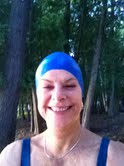 My last swim was at 7:15 p.m. last Thursday, Sept 19th, water temp. 68, air 70. It was such a beautiful evening that even though I’d taken a fairly long walk with my uncle that afternoon, I decided to swim. It was supposed to rain on Friday, and I had to pack up and leave, anyway.
My last swim was at 7:15 p.m. last Thursday, Sept 19th, water temp. 68, air 70. It was such a beautiful evening that even though I’d taken a fairly long walk with my uncle that afternoon, I decided to swim. It was supposed to rain on Friday, and I had to pack up and leave, anyway.
It’s easier to leave in bad weather. It did rain. But it’s no fun to go in and out to the car with coolers, blender, food processor, boxes of food, clothes, clothes on hangers, my 10 lb. weights, lawn chairs to repair over the winter, wicker rocking chair to take to the re-weaver, computer, printer—pretty much like a real move.
Too much, maybe—walking, swimming, and packing up, carrying stuff out and then up stairs into our house—I’m having arthritic-type stiffness and pains in my hips and knees. A new thing for me. Every shift of my body, every pain, I register in a new way—what does it mean? My oncologist told me that most cancer recurrences reveal themselves in symptoms, not in scans and exams. My first exam after chemo, by the way, was Friday afternoon. All’s well, but I expected as much. It’s too soon, probably, for trouble. It would take a while for a stray cancer cell to begin to do its dirty work.
But I’m not thinking much about this. I’m living my life, as instructed by my oncologist. As far as the hip and knee pain, my guess is my body’s been generally damaged by the abuse of chemo and radiation, and it may be effectively “older” than it was. And then, I AM older. I had a birthday this summer.
My oncologist says you measure success of treatment in two ways: (1) look in the mirror; and (2) birthdays.
I seem to have matured (not the same as birthdays) during this last year. I feel more settled in my skin, less apologetic (to me) for being myself and not the magically wonderful person I had aspired to be. There’s no time left for illusion. If I’m to live this life, I'd like it to be THIS life, not one I invent in my head.
And who is this “myself”? That identity transpires moment-by-moment, but on the whole, I see that my dedication to writing has taken on more of a spiritual dimension, or, rather, I guess I'm more clear about that dimension. I dislike the word spiritual. No one knows what it means. What I mean is that I seem have a new and intimate kinship with my forebears in this practice of writing, and—in a way I can’t fully understand—I'm more sure that this reaching into the inarticulate and trying, daily, to say what can’t exactly be said is noble, soul-saving and soul-wrenching work, not to be apologized for, taken lightly, or distorted by a lust for fame.
It is as crucial as—and maybe identical to—the nun’s prayer, the priest’s vow.
Your next question, if you know me at all, might be “How does your Buddhist practice fit into this?” I started the practice, as do most people, because I was anxious and going through a difficult stretch. I wanted some peace, meaning at that time, I suppose, escape. It didn’t take long for me to see that the escape route is into, not out of. I meditate daily because I see for myself that this practice just plain works over the long haul. It appears that the more a person's awake to how things actually are, the more true the life, and the words, can be.
I’m deeply grateful to my Buddhist teachers, past and present, and want to be helpful to them, but the role of lay or ordained teacher doesn’t seem to be my bent. When I was a teenager, I thought for a while I wanted to be a minister. What I wanted, it seems—looking at it from this distance—was to be intimate with what’s real. And then somehow speak that intimacy. Looks as if I’m the same person I’ve always been. Or, I’m like a snowball, getting fatter with my past clinging to me as I roll downhill.
Roll? A subtle Wobbly Bicycle allusion?
Next week: An interview with myself about my new book of poems!
